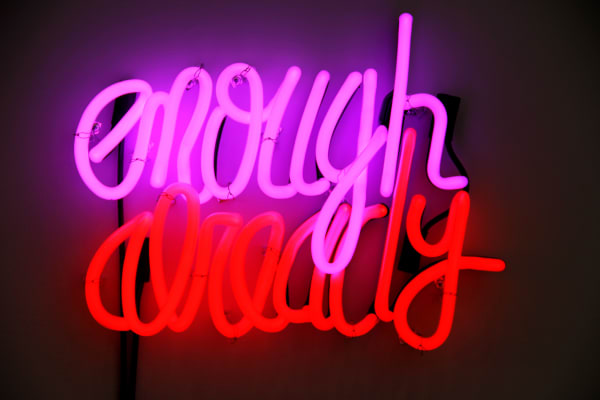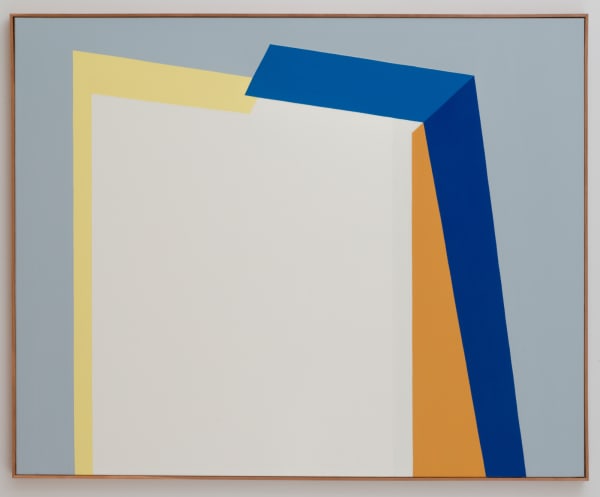-
-
What Once Was Old is New Again
The simple pleasures of the culture world are returning again to the lives of many. New perspectives are possible given the mass social impact of the COVID pandemic.
This presentation of work both old and new touches on the physical exhibitions past, present, and future of the gallery, a model of in-person interaction we look forward to having restored soon.
-
EXPLORE IN VR
-
In Pacot, the neighborhood in Port-au-Prince where Manuel Mathieu grew up, there was a man whom people considered eccentric, or perhaps not "in his right mind." Many people, however, including Mathieu's family, considered him a friend, and sometimes played the role of his protector. But he was at times recalcitrant. Mathieu recalls how dear this man was to him, and when the man died his presence stayed with Mathieu. On a trip back to Haiti before the man's death, Mathieu took a photograph of him and on the photograph wrote the question in Creole, "MANNO KOTE'W?" or "Manuel where are you?" This painting, Will, from 2018, was inspired by this man, and that photograph.
-
-

-
-
This painting by Alfred Conteh is one of the latest in a series titled Two Fronts. For this series, Conteh paints the people that he meets where he lives and works in Atlanta. He presents his subjects as they really are, yet allegory is embedded heavily within the materiality of his work. His materials include battery acid, rust, and metal dust, giving the surfaces of his paintings a quality similar to that of the decaying, neglected buildings that dot the landscape of the neighborhoods captured in his paintings. This is not just an aesthetic choice, but a call for viewers to confront the reality of the world we all live in.
-
-
These works were created for Familiar Spirits, Kour Pour's debut solo exhibition with Kavi Gupta. For the show, Pour created a stunning new body of work conceived around the idea of family—not only that into which we are born, but the families we construct as our personal histories unfold.
To make the works in Familiar Spirits, Pour innovated a new block printing process in his studio. These works are two of 12 colorful tiger paintings that were presented side by side in the exhibition and wrapped two adjacent walls of the gallery. The series could be seen as a single work—a family of paintings. Each piece is also an individual, with each tiger expressing a unique emotional state. The colorful, seemingly abstract shapes in the images were extracted from the underlying, block printed images of the tigers and painted in a primary color palette suggestive of the Bauhaus or early Modernist artists, such as Joan Miró and Alexander Calder.
-
Black. White. Blue. Green. Purple. Red. Color is essential to Mary Sibande’s life and art. She was born Black in Johannesburg, South Africa, in 1982— part of the majority, yet oppressed by the institutionally white supremacist Apartheid system, which granted minority whites supreme political control. Sibande’s mother was a domestic worker, her uniform a standard, blue dress with a white lace apron and head scarf. Sibande's father, dressed in green fatigues, served in the South African Army.
When she was just seven years old, Sibande watched as the police turned water cannons filled with purple dye onto anti-apartheid protestors days before national elections. The purple dye was intended to make protesters easier to arrest, and indeed hundreds were rounded up and jailed. Yet, protestors commandeered one of the cannons and turned it on the governing party’s legislative offices. After the riot, graffiti around the city foretold, “The purple shall govern.” Six years later, Apartheid would officially end, but still today racial inequity is rampant in South Africa. Sibande expresses the frustration of contemporary Black South Africans with the color red, a choice stemming from the Zulu aphorism “ie ukwatile uphenduke inja ebomvu,” meaning “he is angry, he turned into a red dog.”
-
Enough Already (2012) belongs to a series of works titled feel good paintings for feel bad times, which Deborah Kass created in the decade following the contentious presidential election of 2000, as well as the ensuing terrorist attacks on the US in 2001 and resultant War on Terror. These works deploy nostalgia as a potent aesthetic device. They draw liberally from various postwar, 20th-century, male-dominated aesthetic positions, especially those of artists such as Ellsworth Kelly, Frank Stella, Jackson Pollock, Andy Warhol, and Ed Ruscha. Using mid-century, vibrant, optimistic formalism as a structure on which to embed hopeful lyrics from Broadway, pop music, film scores, Yiddish traditions, and the Great American Songbook, Kass created electric, visual mash-ups that inspire reflection on the differences between the contemporary zeitgeist and that of the period following World War II.
-
-
This painting is one of a series of works Young-Il Ahn made as a memorial in the wake of the terrorist attack on the US on September 11, 2001. Ahn married his wife Soraya on September 9, 2001, and two days later, the attack would rock them as it did many Americans. Soraya’s three grown daughters had flown to California from New York for the wedding; this close brush with the attack charged it with all-the-greater weight for Ahn and his new family. These mysterious, grim paintings emanate a sense of pain and sorrow, rather unlike the jovial rhythms of his other canvases.
The September 11th paintings are an extension of Ahn’s Self-Reflection series. One of his most personal bodies of work, it shares many of the organizational hallmarks of his Water paintings, including compositional reliance on a grid, impasto marks, and similarly worked surfaces. But the autobiographical content of these paintings lends them a unique character within his oeuvre.
Woven into the abstract grids of the Self-Reflection paintings are a series of linguistic symbols, including references to the Korean language's logically ordered, alphabetical writing system called Hangul and its logographic symbols borrowed from Chinese called Hanja.
-
-
José Lerma’s practice investigates painting and attempts to collapse the historical with the autobiographical. His works are part art history, part personal mythology, and several recurring themes deal with the tension between the heroic and the pathetic, as well as the rise and fall of great figures. While his work is rooted in painting, the final product usually results in elaborate installations that are often created with office materials, musical instruments, and home furnishings.
-
-
These works were exhibited only once, in 2013. It represents an extraordinary glimpse into a crucial moment in the development of a rare talent. In the early 2010s, after taking a break from painting to refocus the intentions of her practice, Rojas entered a period of fruitful experimentation that culminated in her transition from folk-inspired figuration to abstraction. This period resulted in the creation of the stunning body of abstract paintings documented in her monograph Plain Black: Abstract Paintings by Clare Rojas. Timeless and whimsical, the Plain Black paintings mark the formative stage of Rojas's shift towards plasticity as content: an evolution in style that saw her flat, colorful, abstract forms take on an almost narrative emotional presence. They signify a groundbreaking time when Rojas first mapped the liminal space between geometric and biomorphic abstraction, defining the distinctive visual language she employs today. All but a handful of the works documented in Plain Black have already been placed in private or institutional collections.
-
Tony Tasset's Angry Sun glares from its idolized perch, a flaming personification of godly kitsch interrogating humanity’s contentious relationship with nature. This work was created for Tasset's 2020 solo exhibition The Weight at Kavi Gupta. For this exhibition, Tasset mined the innermost provinces of the contemporary human psyche, responding to the anxiety of our times with wit, gravitas, and salt-of-the-earth sagacity. Working in his western Michigan studio like an aesthetic Dr. Frankenstein assembling an assortment of Post-Modernist monsters—part Woody Guthrie, part Robert Crumb, part Jeff Koons, part Louise Bourgeois—Tasset has concocted a confident, unified sculptural statement he describes as “a reckoning; an apocalyptic mix-tape.”
-
-

-
Beverly Fishman’s highly-polished Pill Reliefs utilize pharmaceutical forms as the basis for seemingly abstract compositions that radiate with color. Made with urethane automotive paint and medium-density fiberboard (MDF), the works sometimes reference a single pill form and other times, as in this work from 2020, they present an assemblage of pill forms — a chemical cocktail. Integral to the success of this work is the presence of distinctive voids in some of the pill forms. Nicknamed Missing Doses, these pieces engage the vacant, interior spaces with color and light. Fishman is directly referencing the transformative power of pharmaceuticals and the transcendent potential of visual art, suggesting the ways people have come to use both as an avenue through which to seek the sublime. The color-and-light-filled forms evoke both the metaphysical theories and aesthetic strategies of the Light and Space Movement, as the missing pieces activate emptiness, exploring the creative potential of voids and raising questions about what truly is the subject of the work.
-
-
Roger Brown (b. 1941, Hamilton, Alabama, USA; d. 1997, Atlanta, Georgia, USA) was a keen commentator on contemporary American life. Born in the Deep South and spending his adult life primarily in the Midwest, Brown was perennially marginalized by his status as an out gay man. He mobilized political figuration in painting with fearlessness and wit to communicate the political realities that comprised his lived experience of the world.
Brown was a pioneering American artist whose extensive and diverse oeuvre both translated and transformed the visual and cultural landscapes of his time. Brown was a leader among the Chicago Imagists, yet his work transcended regionalist concerns and set him apart as a radical visionary amongst his contemporaries. Born and raised in the rural South, Brown moved to Chicago in the early 1960s. His interests ranged from the Italian Renaissance, to Surrealism, to Comics and Pop Art, and he was a connoisseur of autodidact art traditions of the American South and Midwest.
-
Bad Weather seems to be an extremely prescient nod towards climate change, a grim storm on the horizon. The painting only barely focuses on evidence of its own title, instead filling most of its space with numerous felled trees, and two men actively cutting down more. A quarry or mine at the center divides the landscape. Brown's concern for the environment seems to be the focus of the painting, proposing that its "Bad Weather" title must have some causal connection to the devastation of the landscape.
-








































